#toxoplasmosis the fox
Explore tagged Tumblr posts
Text

Quick doodles of Toxoplasmosis! The sparkle fox i live with -w-;
<3 <3
#every one look at my carers awesome fursona now!#Toxoplasmosis the fox#Soap the cat#kips art#fursona#furry art#sparklefur#i think its cool he's immune to frost bite apparently
80 notes
·
View notes
Note
Hello, I have an outdoor cat. That's something I type nervously as people tend to paint such a person as an irredeemable sinner with a special circle of hell waiting for them - I made the mistake of reading the comments. The more people are rude and righteous about it, the more I am inclined to ignore them. However, I saw one of your recent posts about the dangers of letting your cat outside. I was wondering what diseases and parasites are outdoor cats likely to get? You can give them preventative treatment for worms (round and heart), fleas and ticks. You can immunise them against cat flu, feline infectious enteritis and feline leukaemia virus. And you can spay/neuter to avoid kittens. Are there other diseases my cat is likely to get from going outside? I do think it is a very strong argument for not letting your cat out to protect the local wildlife and something I am strongly considering since she caught a bat. I restricted her to not going out from dusk during summer after that. The other arguments don't really feel all that strong to me - there aren't other dangerous predators around (unless you count dogs or foxes and I have only heard of a fox harming a cat once in my life). She is very unlikely to get killed in traffic where we are so that's low risk enough for me to discount it.
well, the big ones are FIV, FTP (distemper), rabies, and any number of cat-specific rhinoviruses. parasites like tapeworms and toxoplasmosis are also a concern, and a major issue is that free roaming cats can easily ingest lethal levels of poisons by doing things like drinking from puddles of antifreeze, or eating rodents that are dying of rat poison.
another real and pressing danger to outdoor cats is. outdoor cats. cats fight each other all the time, and fights can often result in some pretty gnarly injuries. the kind that cost big bucks at the emergency vet to fix, if your cat is lucky enough to make it home afterwards.
also, humans are terrible! strays and free-roaming cats end up picked up for use as bait cats or just harmed for funzies all the time.
and if any of these things happen to your cat, you probably won't ever know for sure. your cat just won't come home one day, which is what happens to the vast majority of outdoor cats eventually. it's often more a question of when than if.
#don't be dicks in the notes please I mean it#also a lot of the bones that turn up on the animal identification reddits I frequent are cat bones
293 notes
·
View notes
Text
Dear Sephiroth: (a letter to a fictional character, because why not) #122
I made a tea today. I made the vanilla-rose black tea. I think you'd really like this one, actually. I took some pictures for you.
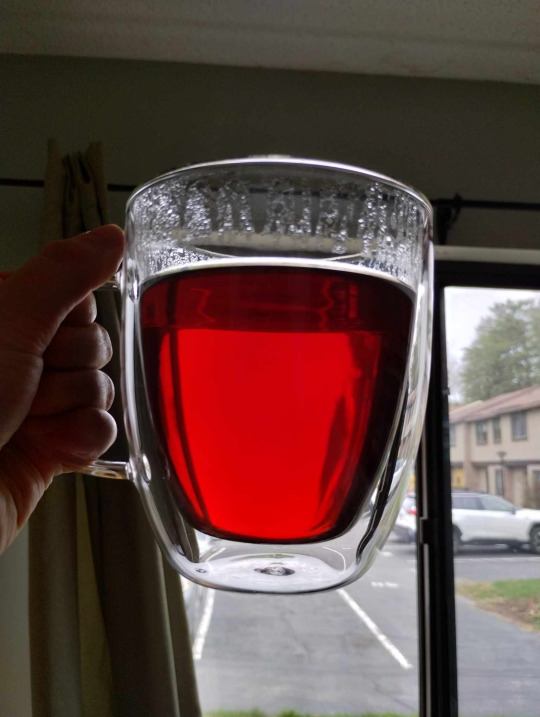






…But that's not what I'm gonna write about today. One of my cats managed to catch a bird. And if you don't wanna be sad, I imagine you should stop reading here.
Our house has a little backyard area that's about the size of a postage stamp. We would like our cats to be able to enjoy fresh air, but the outdoors is not safe where we live for a variety of reasons - the HOA puts pesticides and herbicides everywhere, and we manage to live near nature and near a city at the exact same time, so not only would our cats need to worry about foxes and owls and other birds-of-prey, but also cars and dogs and people. So we built a barrier out of chicken wire so that at very least, our cats can enjoy fresh air without getting hurt.

There's really nothing for birds in our backyard space; it's made primarily of concrete. It's messy. And it obviously reeks of cats, because we have 5 of them. So I'm not really sure how a bird managed to get in there; typically they are smart enough to only chill on the fence posts, aware that there are predators afoot, and that they shouldn't get too close. I guess this one wasn't typical:
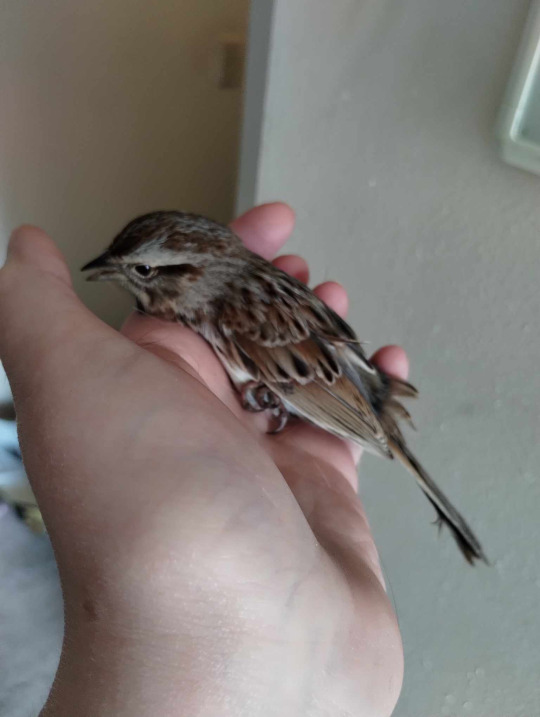
I can't be angry with Arremo; he is only doing what cats are built to do, with exactly the efficiency and skill that he is built to do it with; it's how they survive in the deserts to which they are native. And we're used to chipmunks coming into our yard despite the obvious presence of predators far larger than they are; admittedly I'm not sure what possesses them do it - toxoplasmosis, maybe?
In any case, normally, what happens is that we hear the struggle, we go out, we pry the cat's jaws open to get the animal out of them, and we either bring them to a nearby place (10 minutes by car) called The Animal Hospital for treatment, or they're just stunned briefly and end up running off after a few moments. We can't let our cats eat what they catch, because we don't know if they're diseased, but we do know that they've been exposed to pesticides and herbicides; the last thing we need is for our cats to get poisoned or sick.
When I pried open Arremo's jaws to retrieve the bird, I expected it to be much the same as what I've described with the chipmunks; at first, the little thing seemed alert, but just stunned and scared. It wasn't bleeding; there were no fluids leaking onto my hand as I held it. So I prepared a small box to take it to The Animal Hospital; here's a picture of what I prepared, taken at the end, after everything else happened:
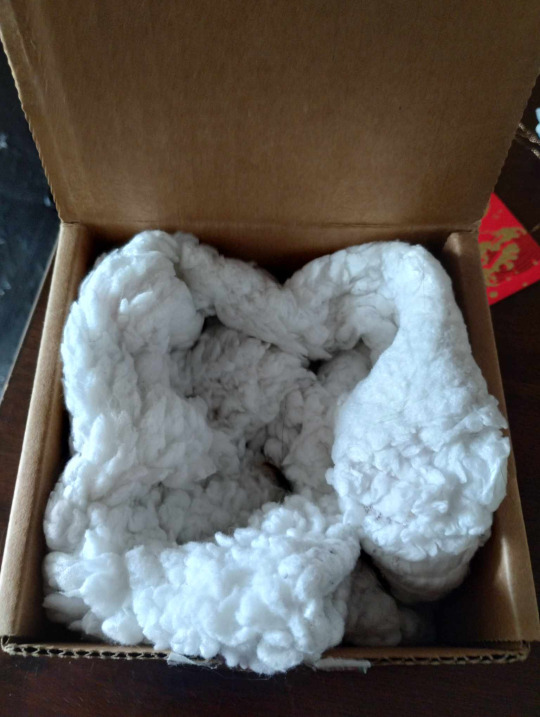
…However, once my mind was no longer occupied by preparing the box, I had an uneasy feeling. My instincts told me that I needed to turn the bird over, so I did. If you're squeamish, then you should skip the rest of this paragraph… …I'm not entirely sure how it can be that no fluids got on my hands; its belly was cut open with near surgical precision, and all the expected things were clearly visible and moving, even if some of them appeared to be missing - the power of a cat's hunting equipment, I suppose. I won't describe what I saw any further, and obviously, I didn't take a picture.
I couldn't avoid falling to my knees and weeping for the creature's suffering in response to what I saw. But once I was able to speak again (it didn't take me long to regain my composure, but my eyes still have not stopped leaking, even as I am writing now), I asked M to bring me to The Animal Hospital (because I was in no condition to drive) anyway; I knew that they wouldn't be able to save it, but I did know that they'd be able to euthanize it, and I didn't want the creature to be in pain for longer than it had to. So I carefully put it in the box, and we went.
We got about halfway there when it started spasming. I have some basic knowledge of anatomy; I understand that spasms can be the result of too much blood loss. I knew then that the poor thing couldn't go on, so I picked it up and held it in my hands until it passed on. Maybe it's silly, but I thought it would be good if its final moments could be in the soft, warm hands of something that sees it and loves it, even if I didn't know the creature very well. I didn't want it to feel alone.
We turned around and went home. From there, I retrieved the daffodils that Br cut and brought to us recently; they smelled heavenly. Then I went out with the daffodils and the body of the bird to the nature trails near my house; I wanted to lay the bird to rest in a place without pesticides or herbicides or the sound of lawnmowers and weedwhackers. J went with me, and helped to keep me focused and stable.
We walked on the trails for a while. Eventually, I found a peaceful-looking mound of dirt with some fuzzy-leafed plants growing on it. I arranged the daffodils so the flower would be in kind of a circle, and then set the body of the bird on top of them:


I thanked the creature for existing, for gracing the world with its presence and song, even if its life was cut short. Then we went home. Some scavenger will likely come along to eat the body of the bird, and it will be a source of nourishment, and then it return to the soil, just as it should; the cycle of life continues.
On the way home, though, we saw something weird. J and I found some lines drawn in the sand, presumably with a stick; we paused in the spots where circles were drawn. I didn't think to take a picture.
But then, I found 7 tiny little whiteish-greyish-blue feathers, all in a line on the dirt path, near the exit of the trails. It was very odd, so I took pictures of the little feathers:
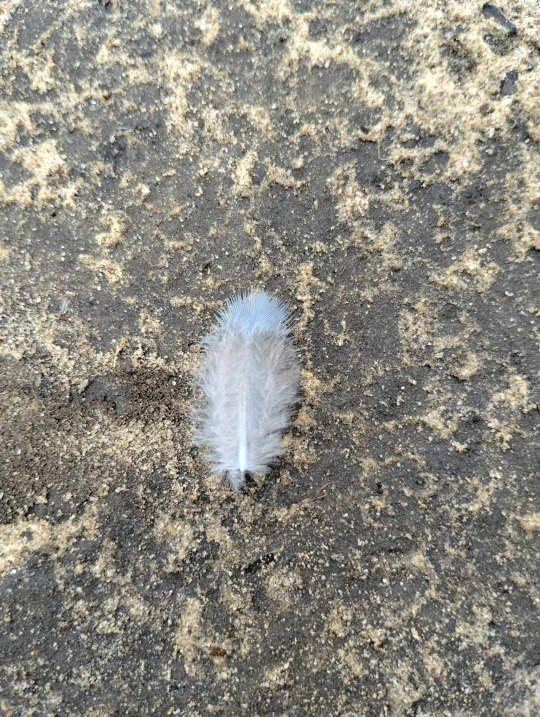


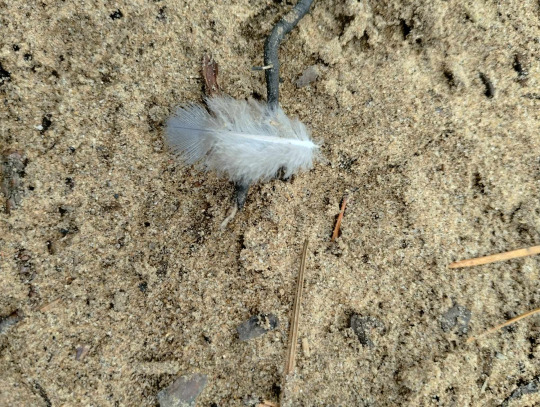

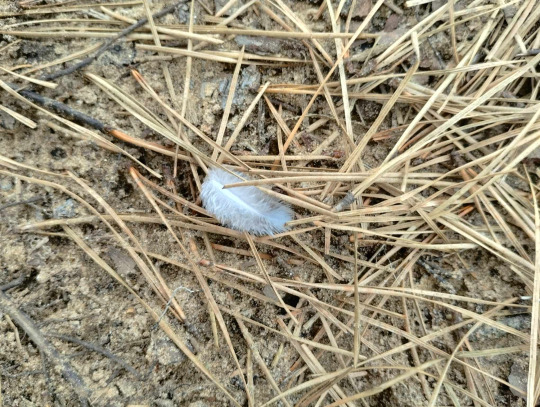
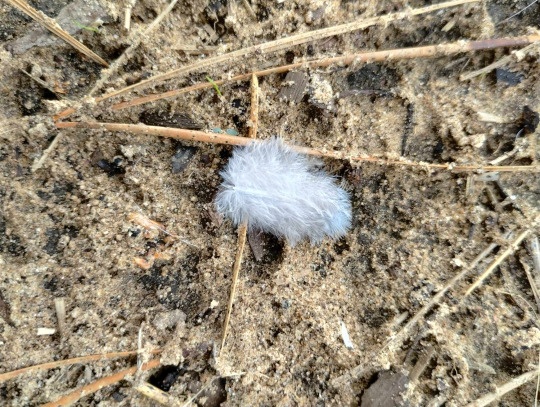
…Maybe the little birdie is okay, wherever it went off to after it exited its vessel.
I washed my hands thoroughly after I returned home. I'm not really sure what to do now. I suppose I'm still stunned. My face is still leaking, and my body is still trembling from time to time. I know I'll be okay eventually, so don't worry about me. But for now, I guess I'm in some kind of weird mental space. My descriptions of what occurred feel very mechanical compared to the intense swirling of the inside of my mind.
My biological family would tell me that it's just a stupid fucking bird, that they die all the time, and that I need to get over it, because it's not worth feeling sad, let alone crying over. But you know? Maybe it's okay that I'm still soft enough to cry over a bird, despite everything. And maybe it's okay that I tried to help, even if saving it was impossible. Maybe it's okay that I tried to hold and comfort it before its last breath, and maybe it's okay that I spent time trying to find a peaceful place for it to rest afterwards. Maybe it's okay to believe that choosing to be gentle, loving, and kind, even in a place where there is so much senseless pain, is where true strength lies.
Sephiroth. I'll recover from the loss of the bird. I won't recover from the loss of you. Don't do something stupid and end up getting yourself killed. Please.
I'll write again tomorrow. I love you. Stay safe.
Your friend, Lumine
#sephiroth#ThankYouFFVIIDevs#ThankYouFF7Devs#ThankYouSephiroth#final fantasy vii#final fantasy 7#ff7#ffvii#final fantasy vii crisis core#final fantasy 7 crisis core#final fantasy crisis core#ffvii crisis core#ff7 crisis core#crisis core#ff7r#final fantasy vii remake#final fantasy 7 remake#ffvii remake#ff7 remake#final fantasy vii rebirth#final fantasy 7 rebirth#ffvii rebirth#ff7 rebirth#final fantasy 7 ever crisis#ffvii ever crisis#ff7 ever crisis#ffvii first soldier#love for small things#peaceful resting places#wholesome
6 notes
·
View notes
Text
More tags, adding on more length to this post (I hope this doesn’t become the new “do you love the color of the sky”)

You may be thinking of minks, which are another type of mustelid related to ferrets. Minks are bred in fur farms and fur farm minks are larger and softer than wild minks. Since they’re bred in human care, they do tend to be much tamer than a wild mink would be, however, they are not truly domesticated. They’re bred for size, color, softness, and ease of care in a fur farm setting, not for ease of care in a person’s house. Still, some people keep them as exotic pets. As they are semi-aquatic, they require access to water deep enough to submerge in at all times, a varied diet, and a rigorous enrichment program. These are things that can not be provided by a single household. I agree with your friend, if they were in fact talking about minks! If not though, ferrets are good alternative pets to keep but definitely require a specific type of person able to keep up with their enrichment needs and diet, as you’re probably not going to be using them to hunt rabbits.

No, it can take hundreds of generations for an animal population to have evolved enough to be considered domesticated. What you are thinking of is habituation. Habituation involves training an animal (whether intentionally or not) to lose its fear of humans. This is incredibly dangerous for the animal. Some habituated animals end up in zoos, but most end up needing to be euthanized for both the animals’ safety and human safety. It also leads to the spread of zoonotic diseases such as rabies and toxoplasmosis. I really hope you’re joking about luring foxes into your home.

Siberia is in Asia, and from what I read while researching for this, most can agree that dog domestication happened somewhere around there. I’m sure it would have been more Northern, as that’s where Pleistocene Wolves would have been ranging.
I don’t think we can truly ever get an exact area though. All the other animals on this list were domesticated during or after the advent of civilization. Dogs were domesticated when humans were still migratory hunter-gatherers, which is just wild to me.

There is actually a type of sheep called the European Mouflon, which were descended from feral sheep (similar to how wild hogs are descended from feral pigs). I worked with some at one point and they are insane. I can not imagine how the first round-up of truly wild Armenian Mouflon went.

Thank you for pointing this out it’s literally my favorite scientific name

I would be up for it as long as any educators contact me first, after which I can send them the high-res images. I don’t like my stuff being used without permission. I’d also want some time to correct issues I’m already noticing (I forgot to add blood sport for chickens and also the afformentioned misleading way I seemed to include spider ball pythons as a breed rather than an example of unethical breeding).

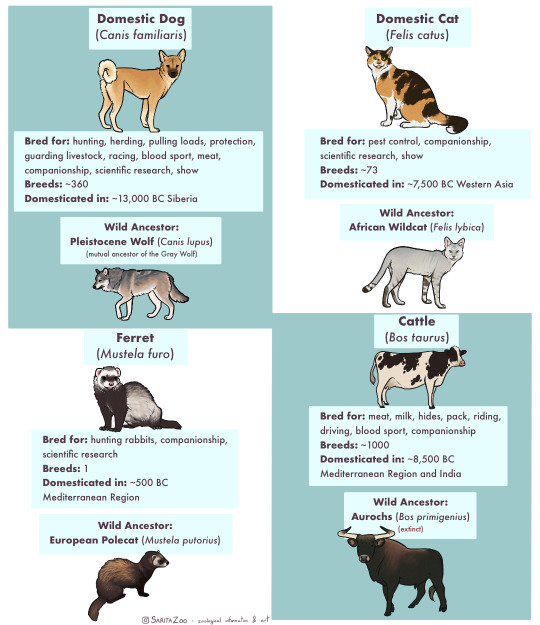


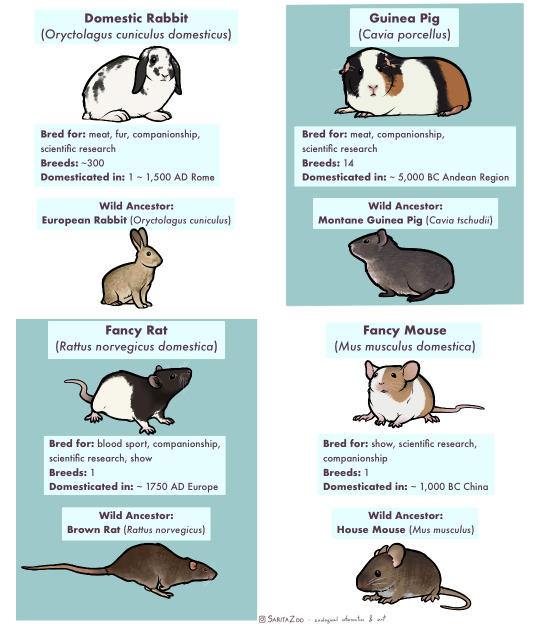
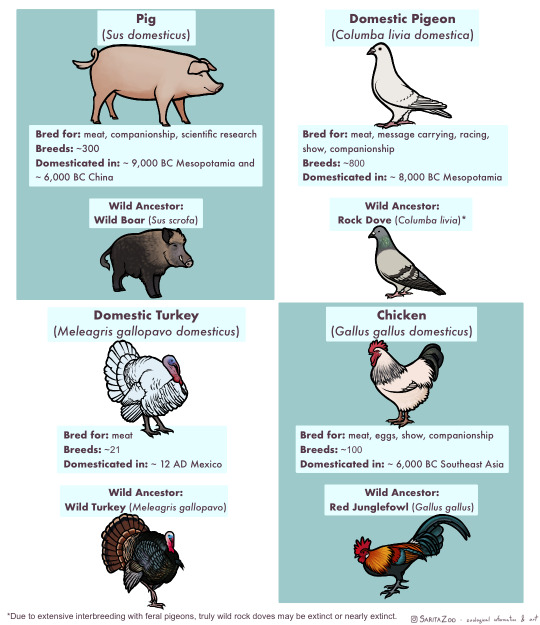
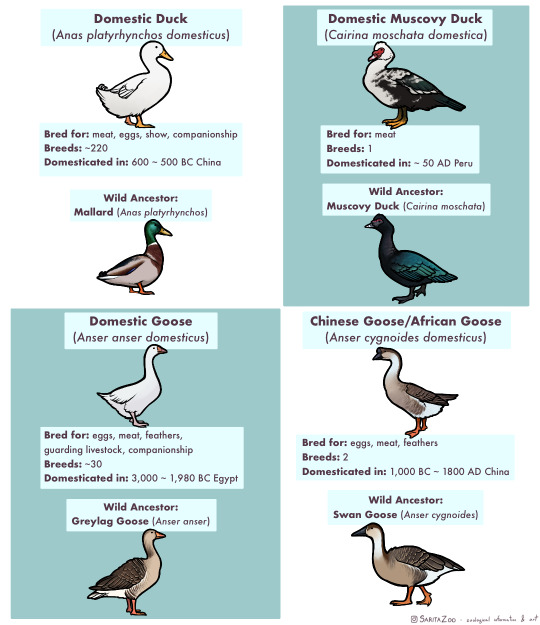
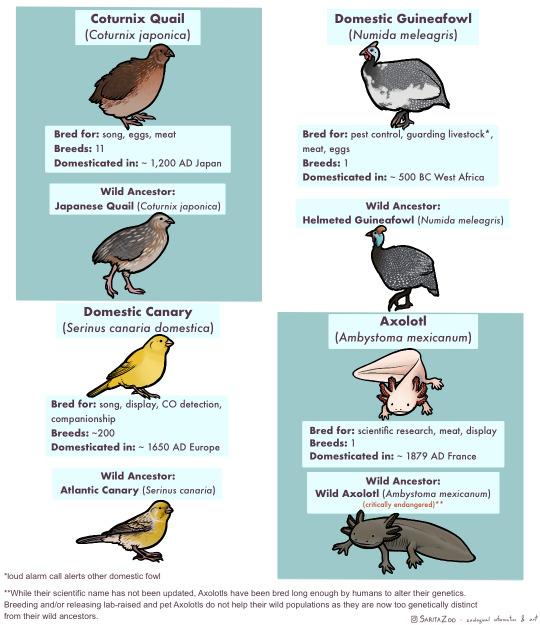
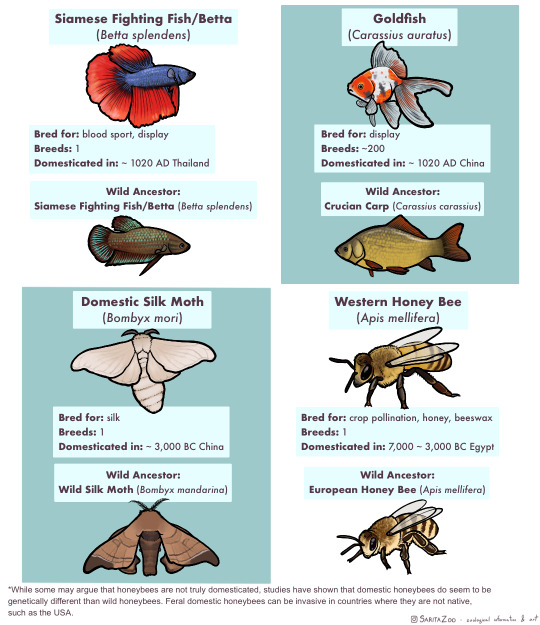

Phew. This one took, uh… a bit longer than expected due to other projects both irl and art-wise, but it’s finally here. The long-awaited domestic animal infographic! Unfortunately, I didn’t have enough space to cover every single domestic animal (I’m so sorry, reindeer and koi, my beloveds) but I tried to include as many of the “major ones” as possible.
I made this chart in response to a lot of the misunderstandings I hear concerning domestic animals, so I hope it’s helpful!
Further information I didn’t have any room to add or expand on:
🐈 “Breed” and “species” are not synonyms! Breeds are specific to domesticated animals. A Bengal Tiger is a species of tiger. A Siamese is a breed of domestic cat.
🐀 Different colors are also not what makes a breed. A breed is determined by having genetics that are unique to that breed. So a “bluenose pitbull” is not a different breed from a “rednose pitbull”, but an American Pitbull Terrier is a different breed from an American Bully! Animals that have been domesticated for longer tend to have more seperate breeds as these differing genetics have had time to develop.
🐕 It takes hundreds of generations for an animal to become domesticated. While the “domesticated fox experiment” had interesting results, there were not enough generations involved for the foxes to become truly domesticated and their differences from wild foxes were more due to epigenetics (heritable traits that do not change the DNA sequence but rather activate or deactivate parts of it; owed to the specific circumstances of its parents’ behavior and environment.)
🐎 Wild animals that are raised in human care are not domesticated, but they can be considered “tamed.” This means that they still have all their wild instincts, but are less inclined to attack or be frightened of humans. A wild animal that lives in the wild but near human settlements and is less afraid of humans is considered “habituated.” Tamed and habituated animals are not any less dangerous than wild animals, and should still be treated with the same respect. Foxes, otters, raccoons, servals, caracals, bush babies, opossums, owls, monkeys, alligators, and other wild animals can be tamed or habituated, but they have not undergone hundreds of generations of domestication, so they are not domesticated animals.
🐄 Also, as seen above, these animals have all been domesticated for a reason, be it food, transport, pest control, or otherwise, at a time when less practical options existed. There is no benefit to domesticating other species in the modern day, so if you’ve got a hankering for keeping a wild animal as a pet, instead try to find the domestic equivalent of that wild animal! There are several dog breeds that look and behave like wolves or foxes, pigeons and chickens can make great pet birds and have hundreds of colorful fancy breeds, rats can be just as intelligent and social as a small monkey (and less expensive and dangerous to boot,) and ferrets are pretty darn close to minks and otters! There’s no need to keep a wolf in a house when our ancestors have already spent 20,000+ years to make them house-compatible.
🐖 This was stated in the infographic, but I feel like I must again reiterate that domestic animals do not belong in the wild, and often become invasive when feral. Their genetics have been specifically altered in such a way that they depend on humans for optimal health. We are their habitat. This is why you only really see feral pigeons in cities, and feral cats around settlements. They are specifically adapted to live with humans, so they stay even when unwanted. However, this does not mean they should live in a way that doesn’t put their health and comfort as a top priority! If we are their world, it is our duty to make it as good as possible. Please research any pet you get before bringing them home!
#phew#hopefully that’s it for now unless I see more tags I feel really need addressed#if anyone has any questions though my ask box is open!#long post#SaritaZoo#Domestic animals#domestication
33K notes
·
View notes
Text
There's a real issue with a lack of wildlife education in the UK. Myself and @queerautism came across a fox (at least one, possibly two, we saw this in several separate areas but it's possible that the fox simply moved around) in the park today that was exhibiting really worrying behaviours. Coming directly up to humans, within about a foot of them. Not being spooked or startled by loud noises, by dogs, or by vehicles. Standing still within a few feet of humans for five straight minutes without really moving.
Those are either signs of illness affecting behaviour, or extreme habituation towards humans. Both are dangerous. Wildlife here don't have rabies, but they are still dangerous. Fluid contact is still a concern. They are still vulnerable to toxoplasmosis, and can cause significant damage with a bite.
We had to warn several people away from it, because the immediate response to the fox was not concern, it was trying to beckon it closer, to feed it. Because it was friendly. These things are curious, but they're skittish as fuck. I've never before gotten within 20 feet of one before now, and we came across it several times as we went around the park.
It's not people's fault they've been failed, of course. I'm luckily from a semirural background where contact with large animals was a part of the curriculum, as was basic wildlife safety and respect for livestock. That isn't the case for many people.
Where I'm most angry is that myself and Rouke did our best to find an animal control number, only to find that the only option was a dog control service. Which was closed. The next was the RSPCA. Which was also closed. The only advice said to call the non emergency police helpline. When we did, they directed us to the RSPCA, which is NOT a government service. The number they gave us was the emergency number. It was still closed.
We couldn't find a single local resource for dangerous animal reporting in our county. We had to leave, because the proper authority had said they weren't trained for that and couldn't handle it.
If the fox is infected with something, it will almost certainly bite. If the fox is habituated to being fed by humans (another massive issue in this country) it will likely bite if someone interacts closely with it without feeding it. I wish there was something we could do, but there is literally no available service for this.
70 notes
·
View notes
Text
There’s a lot of those is-this-insert animal-video-cute blogs and I so want to do one for foxes but I feel like a lot of people would disagree with some of my opinions.
For a start I don’t think pet foxes are the worst thing in the world. Not that I agree with breeding and selling foxes for the pet market, but at the same time I do recognise that there are some great fox owners out there and with the right care they can thrive in captivity, unlike so many other exotics. The foxes on the pet market are also a good 150+ generations removed from their wild counterparts. That doesn’t make them domesticated, but at the same time many have been bred to be more tame over the generations and it’s not quite on the same level as most other exotic mammals. It’s hard to categorically state something isn’t cute if the animal is happy and well cared for. The main issue with pet fox videos is no matter how many disclaimers you add it still encourages people to want one who may not have the knowledge and space to care for a fox properly. So that’s a tricky one.
Probably even more controversial, but I’m not completely against feeding wild foxes either. Done right it really doesn’t cause any issues. Foxes in urban areas are getting most of their food from humans one way or another so a little bit of supplementary feeding can benefit foxes without changing their behaviour or making them less afraid of humans. Foxes are smart and even ones regularly fed by people will still avoid direct contact with them. It’s common for urban foxes to learn to recognise and trust someone who feeds them but still keep their overall fear of people. I wont bother going into the subject too much but someone I know wrote a good article on the subject here
The main problems with feeding are people putting out too much food, leaving out unhealthy foods (like cake and chocolate), luring foxes close to them with food or encouraging them into their house. All things I sadly see far too much of online. But simply scattering a few dog biscuits or peanuts at the back of your garden and putting up a trail cam or watching them from a discreet distance isn’t going to do any harm. It’s still not something to be encouraged but at the same time it’s not the automatic death sentence some people seem to think. Feeding can also be a great tool for giving medicine to sick or injured foxes without the need to trap them for treatment.
Most stories of urban foxes acting overly tame/approaching people are due to one of the following;
the fox having a condition like toxoplasmosis. This is very common in urban areas and causes brain damage that makes the fox not only lose it’s fear of people but actively seek them out. Other conditions, like mange, can also make foxes less fearful
the fox having been tamed from a very young age so it never got the chance to learn it’s natural fears. This is quite rare but it does happen. Sometimes people even try to keep cubs as pets then release them when they become older
the fox suffering some kind of toxic poisoning that results in brain damage. Chemicals used on icy roads during the winter are a common cause of this. Rat poison and slug pellets are another common source of poisoning in foxes
people misinterpreting fox behaviour. Just because a fox stops to look at you before trotting off does not mean they have no fear of people. It’s common for even rural foxes to stop for a few seconds to look at you before running off. Urban foxes are so used to seeing people around that they’re not going to waste energy running for the hills if a person passes them on the other side of the street. They have more important things to do.
10 notes
·
View notes
Text

doodles of Soap the cat my fursona!
#i finally had sometime to draw today#furry#furry art#soap the cat#toxoplasmosis the fox#my art#kips art
108 notes
·
View notes
Text
Heaven 4ur Pet Pennsylvania
Handling your pet’s illness and infections
Introduction
As a pet owner, dealing with a sickness that affects your pet is one situation that you might one day find yourself in.Pets can contract a myriad of diseases and infect you or your loved ones inadvertently. Therefore, there is a need for pet owners to be in the know as far as contagious diseases are and their respective signs. In this article, we will discuss these issues, with the focus trained on Cats, and Dogs. These two creatures form the bulk of pets in US households and will be at the center of discussion.

Warning signs
Simple behavioral changes such as lethargy, low appetite, or aggression can give early signs. Your pet might appear to be ailing. Humans have evolved to gauge the health of others through simple observation. Other symptoms are more visceral and physical. Some common ones are: ● Abrupt weight loss ● Runny nose and eyes ● Fever ● Excess thirst or urination ● Diarrhea ● Difficulty urination ● Vomiting ● Blood in urine or feces ● Itchy skin ● Hair loss ● Coughing If you notice any of this on our pet, you should rush to the vet immediately. Pet to human infection
Dogs and cats are at risk of being infected with a wide range of diseases. A large percent of these diseases are exclusive to their species, or family, but some can be passed onto the man. Even though pets are important in our daily lives, our health is of priority.
You should consider the age and general health of your family members before getting a pet. If one of your family members has a health history such as a poor immune system or cancer, you should not have pets near them. They are at risk of catching serious diseases that spread from the pets to them. The diseases are discussed below;
Campylobacter infection
This is a disease that is spread through bacteria that is known as Campylobacter jejuni. The bacteria is thought to be within the intestinal tracts of the pet or even a few farm animals. It can be spread to people that contact contaminated water, waste, and ill-prepared meat and milk. The disease will lead to them having symptoms such as diarrhea, abdominal pain, and high body temperatures. More than two million of these illnesses occur in America only. It can be controlled using antibiotics.
Rabies
This fatal RNA virus is spread by cats and dogs. Other animals, like bats, foxes, and skunks might also spread the disease. Humans who get bitten, scratched, or licked by animals that are infected may catch the disease. The virus affects the nervous system, making the victim fear light and water. By the time these symptoms appear, the disease becomes fatal. Treatment can be done immediately when one gets attacked by an infected animal. Infected pets, tend to be aggressive, fearful, and drool persistently.
The two types of rabies include: ● Encephalitic rabies: The patient becomes hyperactive, aggressive, and hydrophobic. ● Paralytic rabies: The patient falls into paralysis. More than 75% of rabies cases in humans are of the first case.
Rocky Mountain spotted fever This is a disease that is spread by ticks that are infected with Rickettsia ricketsii bacteria. These ticks are found in dogs, they lead to pain in the muscles, chills, headaches, fever, and rash. The rash afflicts your palms, ankles, wrists, shoulders, and trunk.
Ringworm
Fungi residing on the ground or on the skin of man and animals is responsible for this disease. One can contract this parasite by touching the infected skin of their pets. This causes affected skin to become dry, flaky, and red or swollen.
Cat scratch disease
This is caused by the Bartonellahenselae bacteria. Bites and scratches by an infected cat can land you this disease. Symptoms include swelling of the lymph nodes, headaches, fever, and tiredness. Doctors may prescribe antibiotics if you have this disease but in most cases, it eases without any medication.
Toxoplasmosis
This is spread by a parasite called Toxoplasmosis Gondii. You can contract this disease when they contact the waste of a cat. This disease causes muscle pain, fever, swollen glands, sore throat, and rash. It is particularly malignant to pregnant women, and their fetuses. Children may be born blind and other serious ailments. It might even cause premature death or miscarriage.
Besides these diseases, bites from cats or dogs can cause infection and bleeding. A bite from a cat is more serious considering their greater depth. For these reasons, pet owners should take adequate measures such as vaccination, cleanliness, and pet hygiene.
Psychologically coping with pet illness

Seeing your pets hurting due to sickness is not easy. It is important to psychologically steel oneself throughout the ordeal. Do not place guilt on yourself. Guilt is counterproductive and generally misplaced. Don’t torment yourself if you forget to give your pet medication one day. Let go of perfection. It’s tempting to try every medication and therapy for your pet. However, this is often not viable due to financial and time constraints.
Ask around for help, and plan for your next action. Don’t be negatively affected by the condition of the pet. Avoid being stressed, and take care of yourself. Enjoy your pet, don’t let their illness overshadow the good times you’ve spent.
Caring for a sick pet
Follow the instructions and prescriptions given by your vet to the latter. Keep the pet in a quiet environment. Don’t let it play with the kids at that time. Ideally, isolate them in a separate room of your house. Let everybody in the household be aware of the dietary needs of the pet. Otherwise, they may unwittingly sabotage your pet’s recovery. Give your pet all the physical attention it needs. It may just be thirsty or need to urinate.
Finding care providers
If you notice any of the above illnesses in your pets, don’t hesitate to take them to the vet. Make sure the vet is accredited with the AAHA, and the clinic is equipped to diagnose the illness.
Conclusion
Above all, stay psychologically strong during these trying times, and follow the advice of your vet. And, never ignore the infection that pets spread to humans, and take the needed measures.
Emergency vet services
Emergency vet services, animal hospital, pet treatments and vaccines, pet fracture and wound management, veterinary surgery and behavior therapy are all services that we currently offer. While we service the York area, we also service the following counties York County, Adams County, and Lancaster County. We work hard feverishly to save your pet. We help pets with fractured bones and offer pet diagnosis with treatment plans. Veterinary surgery is our specialty too.
Name: Heaven 4ur Pet Pennsylvania Address: 706 E King St, York, PA 17403, United States Phone: (717) 229-7419 Website: https://heaven-4ur-pet.com/areas-served/pennsylvania/york/
1 note
·
View note
Text
Wrt to a tag on this post, if there are foxes in your area and you have a garden, there are foxes going in your garden. Foxes will eat berries, slugs, worms, bugs, seeds, mushrooms and a variety of other things that you wouldn't expect but that can be found in your garden.
If you're really lucky, a fox moght even make a den in your garden! If that happens, keep your distance (especially if it's a vixen with kits) and DO NOT FEED THEM. Report any cases of mange to animal control or a wildlife rehabilitation center and leave the den alone unless you have kids or dogs that might approach it. In that case, contact animal control about getting the foxes moved (NOT KILLED); this is actually pretty simple because foxes usually have multiple dens so most foxes will move to another with no issue.
If you have cats, you should absolutely be keeping them inside regardless (domestic cats are invasive!) but know that foxes will absolutely attack small cats and kittens and cats can infect foxes with toxoplasmosis, a highly dangerous disease for foxes especially because it dramatically alters their behavior and their ability to fend for themselves in the wild.
If you are struggling with wild pests in your crops or garden, then the best way to get rid of them isn't by using barn cats or pesticides or whatever, it's by bringing in wild predators.
Wolves and mountain lions and other large predators are always going to be better at keeping deer and coyote populations down than hunters.
Birds of prey, foxes, and snakes are always going to be better at keeping rodents away than cats or poison.
Native predatory insects, rodents, foxes, and birds are always going to be better at keeping pest bugs, slugs, aphids, and the like away than pesticides.
The trick is to work with nature instead of fighting against it, letting yourself and your work be part of the ecosystem instead of trying to stay separate.
1K notes
·
View notes
Text
Keep your cats inside for the sake of their health and the surrounding environment
https://sciencespies.com/nature/keep-your-cats-inside-for-the-sake-of-their-health-and-the-surrounding-environment/
Keep your cats inside for the sake of their health and the surrounding environment
The next time you crack your backdoor to let your cat outside for its daily adventure, you may want to think again. For a cat, the outdoors is filled with undesirable potential. Like the risks of catching and transmitting diseases, and the uncontrollable drive to hunt and kill wildlife, which has been shown to reduce native animal populations and degrade biodiversity.
A new study by University of Maryland researchers has concluded that humans bear the primary responsibility, and that these risks can be significantly reduced by keeping cats indoors. The study’s analysis used data from the D.C. Cat Count, a Washington, D.C. — wide survey that deployed 60 motion-activated wildlife cameras spread across 1,500 sampling locations. The cameras recorded what cats preyed on and demonstrated how they overlapped with native wildlife, which helped researchers understand why cats and other wildlife are present in some areas, but absent from others. The paper was published on November 21, in the journal Frontiers in Ecology and Evolution.
“We discovered that the average domestic cat in D.C. has a 61% probability of being found in the same space as racoons — America’s most prolific rabies vector — 61% spatial overlap with red foxes, and 56% overlap with Virginia opossums, both of which can also spread rabies,” said Daniel Herrera, lead author of the study and Ph.D. student in UMD’s Department of Environmental Science and Technology (ENST). “By letting our cats outside we are significantly jeopardizing their health.”
In addition to the risk of being exposed to diseases that they can then bring indoors to the humans in their families (like rabies and toxoplasmosis), outdoor cats threaten native wildlife. The D.C. Cat Count survey demonstrated that cats that are allowed to roam outside also share the same spaces with and hunt small native wildlife, including grey squirrels, chipmunks, cottontail rabbits, groundhogs, and white footed mice. By hunting these animals, cats can reduce biodiversity and degrade ecosystem health.
“Many people falsely think that cats are hunting non-native populations like rats, when in fact they prefer hunting small native species,” explained Herrera. “Cats are keeping rats out of sight due to fear, but there really isn’t any evidence that they are controlling the non-native rodent population. The real concern is that they are decimating native populations that provide benefits to the D.C. ecosystem.”
In general, Herrera found that the presence of wildlife is associated with tree cover and access to open water. On the other hand, the presence of cats decreased with those natural features but increased with human population density. He says that these associations run counter to arguments that free-roaming cats are simply stepping into a natural role in the ecosystem by hunting wildlife.
“These habitat relationships suggest that the distribution of cats is largely driven by humans, rather than natural factors,” explained Travis Gallo, assistant professor in ENST and advisor to Herrera. “Since humans largely influence where cats are on the landscape, humans also dictate the degree of risk these cats encounter and the amount of harm they cause to local wildlife.”
Herrera encourages pet owners to keep their cats indoors to avoid potential encounters between their pets and native wildlife. His research notes that feral cats are equally at risk of contracting diseases and causing native wildlife declines, and they should not be allowed to roam freely where the risk of overlap with wildlife is high — echoing previous calls for geographic restrictions on where sanctioned cat colonies can be established or cared for.
Story Source:
Materials provided by University of Maryland. Note: Content may be edited for style and length.
#Nature
0 notes
Note
my bff showed me a youtube video about how, without outside cats, the wild rat population would overrun us and eat all our food and spread disease. Can you talk a bit about how accurate or inaccurate that may be?
Hmm, I don’t know if I can give a very certain answer for this, but this is the first I’ve ever heard this claim I’d definitely want to know about the video maker’s science background (if any) and what sources they got their info from.
What I CAN say: another issue with outdoor/feral cats that the post didn’t mention is that they compete with native predators that also hunt small animals - foxes, owls, etc. And they have a big leg up because a lot of them are better off than a typical wild animal; outdoor pet cats still have owners who feed and care for them, and lots of people will feed and give medical care to stray cat colonies. Plus, the native predators just haven’t evolved to compete with domestic cats. Without cats (and ideally better protection of species/habitats), I’m sure native predators would be able to step back up to help regulate the rate/mouse populations. And like the post I reblogged said, there’s other ways to deal with rodents that are more targeted/selective than cats (who will go after whatever they can - they wouldn’t understand being told “hey only go after the rats, leave everything else alone”)
ALSO ALSO, domestic cats can spread diseases to wildlife and humans (notably Toxoplasmosis); rats are far from the only vectors of illness :v
1 note
·
View note
Text
I once met a fox with suspected toxoplasmosis. She just turned up one night out of nowhere and became OBSESSED with me. She tried to follow me everywhere and would ‘talk’ to me using soft vocal calls that vixens usually use with their cubs, and whenever I went back indoors she would cry and whimper for hours. I remember one time she pressed her face up against the front window and was scratching at it to try and get into the house. I’ve known plenty of friendly foxes but none that behaved like her. It was sad as she was very pretty

It’s impossible to confirm toxoplasmosis without testing but she had all the classic signs. Another thing with toxo foxes is that they often have a blank, distant stare. It’s kinda hard to describe but basically a normal fox will look at you while a toxo fox looks through you. You can just kind of tell that they’re not all there.


Unfortunately she disappeared after a few weeks so I don’t know what happened to her, but toxo foxes rarely survive for long in the wild. :( Interestingly, because of the way the brain damage makes them seek out human contact they can thrive in captivity with the right care and there are some organisations and sanctuaries that rehome toxo foxes.
#gotta admit if i magically became rich and had a lot of land i'd love to build a huge enclosure to house toxo foxes#they wouldn't be pets tho and i'd try to give them as natural a life as possible
9 notes
·
View notes
Text
15 Causes You Can not Leave Esther Hicks Or Abraham.
Below are actually 24 tweets that happily sum up being actually a lady online with an opinion. The fluffy white robotic feline actually helps make and also removals pussy-cat sounds that sound very reasonable. Sequans has earlier partnered with Verizon on the deployment of LTE PUSSY-CAT 1 on the Verizon network. Once he has gone the fox comes in. Notification that the fox carries out not come in up until the kitty has actually ended up, this challenges the idea some folks possess that foxes have felines. On the thirteenth time of X-mas his soul mate provided Popper - a negative scenario of the holiday blues. Blue jays breed coming from mid-March through July with peak breeding in mid-April to Might. The bodies present kitty followers spend considerably a lot less each month on their pet dog compared to pet dog owners perform. This could account for some, however certainly not all of felines' violence toward their managers. Breathe out right into cat (arc the spinal column upwards, tuck the jaw towards the chest, attract the navel in to the vertebrae). Regulators are elevating warnings regarding these practices however have actually certainly not but taken professional activity. While the Daemon Feline could initially resemble a benign kittycat, it increases in measurements and evil the more detailed one acquires. This takes place to pets, as well, however the colour is actually normally one thing aside from reddish - such as green, yellow, or even blue. Feline Pine Authentic Non-Clumping Pussy-cat Litter functioned wonderful to eliminate the can stenches. KITTY company style is actually intermittent as well as this does not help routine returns raising. For more details on why LTE CAT M1/M2 makes the Internet of Factors a reality reviewed Appendix 1 at the end this record. They may for that reason be taken into consideration a separate types Even so, off the record taxonomic names for the kitty consist of F. silvestris catus as well as F. silvestris domesticus, along with F. domesticus. The Loc8tor uses modern technology comparable to a homing lighthouse mechanism to find your pussy-cat rather than a FAMILY DOCTOR unit which permits you to track the animal remotely off a website on a personal computer. Determine just how over weight or even overweight your feline is and determine their excellent body system weight. Entrance (pasarela): sistema formado por hardware y software que permite las comunicaciones entre una reddish regional y un grandma ordenador (mainframe). That will create her just about the meanest aunt in the deep blue sea, however will definitely liven up loved ones get-togethers. Sold for merely $17.84 at this is a pleasant choice for pussy-cat lovers ages 3 as well as up The kitty is actually white colored and grey candy striped as well as possesses a fairly blue lace. Some want to consistently become part of a six child, 5 dog as well as 3 pussy-cat team and also others will like to become just troubles all their lives. Don't view excessive ravens around my region, however crows are actually smart and also fairly amazing birds. As the kitty from your home, I experience forced to show to you my thoughts regarding the canine - or even more efficiently, the pet complication. http://vigorizdrowieblog.pl/titan-gel-une-formule-unique-le-dispositif-dagrandissement-du-penis/ is the 3rd biggest feline (after lions as well as tigers) and also they may be located in southern USA, Mexico, most of Central The United States, as well as throughout the north of South America. Keep in mind prior to recycling, that it is inexpedient to recycle pussy-cat clutter, like composting it in the yard, given that kitty feces carries a bloodsucker referred to as toxoplasmosis. I'm instructing making quilts to a great-niece, such a pleasure, and also Oliver has actually had near runs away as well as great pet cat adventures, plus I'm still looking at years of accumulated bedspread things. She has also been actually attributed the electrical powers of granting productivity and also defense versus buccaneers, as well as is typically illustrated wearing her signature reddish garments. The dash acting up might be a poor solder joint on the dash on its own, or even your gas sending element in the storage tank may be actually going out. That was about a week prior to he ditched me. That week was actually when factors began to spoil. Koraliki wykorzystane our experts wzorze to miyuki square 1.8 mm obfuscated rainbow frosted plane, 11/0 silver oraz FP 4mm matte iris blue, arcos the same level Puca silver i blade peacock cloudy blue turquise vitrail matt. Before the market opened this morning, Arctic Pet cat released outcomes for its economic 2017 very first fourth ended June 30, 2016. There is actually a cute canine Kiss along with a little rolled up newspaper in his mouth and also a Pur-fect Kitty Kiss with a jelly bean in his mouth. Real-time monitoring permits you to focus on its own position despite where it is actually. They provide a soft neoprene bag to slip over an elastic safety dog collar for the kitty. Therefore, whether you are naming a family pet, a tiger for a zoo exhibit, a stuffed animal, or even a house kitty that wishes that were a leopard, you are going to likely discover a best title suit on this listing. One vet took note that hamsters may receive an identical problem when their bedding is composed of second-class saw dust or lumber shaving your faces, and guessed that the kind of kitty brood used can easily support pillow shoe in kitties The descriptions in classified advertisements I specifically like are those that feature blue nose, red nose, reverse brindle, Gotti pipe and also everything our experts may consider to sound like our company have a within revelation on one thing that our company definitely must simply phone a mutt.
0 notes
Text
Keeping Cats off Vegetable Beds
19 November 2010, written by Jeremy Dore


Last week Barbara wrote about growing plants that cats will love – a delightful way to indulge your favourite pet. However, not everyone has such a positive relationship with cats in the garden. For those of us gardening in urban or suburban areas they can seem more of a nuisance when our specially prepared vegetable beds become the local toilet for the neighbourhood felines. Having a row of precious seedlings dug up, or finding cat-poo when planting can be frustrating to say the least. So what can be done to persuade them to keep away?
You're reading: Keeping Cats off Vegetable Beds
The first thing to realise is that it’s quite natural for cats to seek out neighbouring patches of earth to use as a toileting area. Unless the owners have trained them to use a litter tray at an early age most cats will prefer to find an area outside their own garden territory. When you consider how many gardens consist of lawns, densely planted borders and low-maintenance paved areas it is no surprise that they often make a beeline for the recently dug bare soil of vegetable beds.
Although the behaviour is understandable it certainly isn’t desirable to have cat faeces near vegetables as they contain a number of disease-bearing pathogens including those that cause toxoplasmosis. Washing home-grown food carefully is one part of the equation but to be on the safe side it’s best to try and keep cats away.
Read more: Are Ladybugs Good for the Garden?

Deterrents
There are hundreds of commercial products available to deter cats but you only have to peruse a few gardening forums to discover that many of them aren’t as effective as the manufacturers would have you believe. Deterrents should also be evaluated for safety as quite a few are not suitable for vegetable gardens. For example, you will often see mothballs recommended but they are highly toxic to young children, dogs and cats and contain pesticides that you are unlikely to want near edible plants.
Generally, deterrents fall into the following categories:
Smells: Strong smelling substances that cats don’t like are often recommended such as orange peel, coffee grinds (try your local cafe for used grinds), pepper etc. These usually need replenishing every few days, particularly after rain. Commercial variants often contain the scents of predators e.g. Silent Roar (contains ‘sterilised essence of lion dung’) or Shake-Away (with coyote and fox urine).
Sounds: Ultrasonic cat repellent devices work by emitting a high-pitched sound, which cats don’t like but humans can’t hear, when there is movement nearby. Battery operated models are available although wired versions are more economical in the long run. An alternative sometimes used is wind chimes but they are rarely popular with neighbours.
Visual Warnings: Some people place short lengths of old hosepipe amongst their plants to look like snakes which cats will keep away from. Bottles of water or CDs strung together can give shifting light patterns that are said to make cats wary.
Barriers: The most effective barrier is to net each vegetable bed but it takes time and money to do this. Another approach is to place spiked strips on all surrounding fences but cats are extremely good at navigating obstacles. Alternatively you can place many spikes in the ground – these can be small sticks about every two inches (pea sticks work well) or trimmings from spiky plants such as roses or hawthorns that will make it uncomfortable for a cat to dig. Unfortunately they also make it very uncomfortable to weed or plant in the area!
Plants: A number of plants are said to be unattractive to cats including lavender, lemon balm and the ‘scaredy cat plant’ Coleus canina. They work by producing smells or having a texture that cats don’t like. Most are annuals and can be raised from seeds or cuttings but that means they are unlikely to be fully grown in spring when your soil needs protection most.
Water: Cats try to avoid getting wet and a sudden blast of water can be an effective deterrent. Motion activated sprays are one way of achieving this although they are quite an expensive option.
Animals: Surprisingly owning a dog is not a good deterrent. However, owning a cat will usually keep others away because they mark out your garden as their territory, though that’s not always a desirable option.

Prunings placed across a vegetable bed make cats less inclined to wander onto the soil
What Works
No single method for deterring cats is 100% effective and many are simply too expensive when scaled to the size of a large vegetable garden. However, there are some good principles to follow when deciding on a course of action:
Clear Up and Replace Scent with Strong Smells: Cats are creatures of habit that use smell to locate their toileting areas. If you already have a problem then the first step is to remove the existing poo, water the surrounding earth to wash the smell away and then spread scented deterrents in the area (citrus, coffee grinds etc)
Use Ground Coverings Where Possible: Keeping the soil covered for as much of the year as possible is good gardening practice anyway so make good use of green manures (cover crops) and mulches.
Make Cats Feel Unsure: Cats don’t like surfaces that feel tangly or wobbly. Stretching netting over beds, running string between posts at the top of fences and using light mulches that a cat’s feet will sink into will all make a cat feel that it’s not on solid ground, encouraging it to go elsewhere.
Don’t be Seen: The classic mistake (I plead guilty to this!) is to chase cats from your garden. The problem is that they then associate you with the danger and it seems they like the challenge of outwitting you! Instead, cat psychology says that we should look for ways to have the cat associate the garden with danger, rather than the human, so a jet of water apparently coming from nowhere will be more likely to succeed than an angry gardener.

A length of hosepipe can look like a snake to cats
There are no easy answers to the roaming nature of cats – I wish there were. However, with a combination of the ideas mentioned above, some success can be had, or at least the problem can move on to someone else’s garden where vegetables aren’t being grown. If you are still struggling then, as a declaration of war, you could try the technique mastered by my retired parents-in-law: sitting in their conservatory with a loaded super-soaker pointed through the open door – a method that they swear has been the most effective of all!
Read more: 14 Best Summer Vegetables to Grow – Garden Design
If you have had success in keeping cats from your garden please do share your tips below.
< All Guides
Source: https://livingcorner.com.au Category: Garden
source https://livingcorner.com.au/keeping-cats-off-vegetable-beds-2/
0 notes
Text
Pet Eye Overall health - What To Seem For
Keeping eyes wholesome is critical each for animals and humans. The spot close to the eyes as properly as the eyes them selves is a quite delicate location. The cleaner this spot is kept the a lot more likely an animal's eye will remain wholesome. Your pet's eyes are critical to their security and effectively-currently being. There are many substances and problems that can threaten your pet's eye overall health and knowing the symptoms of particular issues can assist you foresee and deal with these difficulties before they forever affect your pet's eyesight. Red Eyes Red eyes can signal several diverse inflammatory conditions and infectious conditions ranging from conjunctivitis to glaucoma. The most common circumstances linked with your pet's purple eyes are beneath. Conjunctivitis Conjunctivitis is an swelling of the mucous membranes of the eye. It's the most typical eye ailment in all domestic animals, and it has a variety of triggers. Conjunctivitis may be triggered by a viral or bacterial an infection, by a parasite (like ticks) and by allergies. Ticks in specific can transmit a variety of parasites that can cause conjunctivitis. Treatment for conjunctivitis involves keeping the eye clear and eliminating the cause of the irritation. Dogs with allergy symptoms and purebred cats are most vulnerable to conjunctivitis. Keratitis Keratitis leads to superficial blood vessels and pigmentation on the eye. It can lower vision if still left untreated. It is a frequent eye problem, specifically amongst German shepherds, and the redness is often accompanied by a thick, ropy mucous discharge from the eyes. In serious and continual cases, the eye surface area gets infiltrated with blood vessels, and could harden since of prolonged term irritation. There may also be ulceration of the eye tissue thanks to keratitis. Treatment of keratitis consists of tear stimulants and anti-inflammatory medicines. Eye ulcers may possibly demand surgical mend. Most exterior eye ailments are treated with antibacterial eye drops that must be used numerous occasions a day. Newer systems that take care of eye infections in canine contain a bioadhesive ophthalmic drug insert which can be positioned in the eye to stay away from the daily therapy and make compliance with treatment less complicated. Cherry Eye Cherry Eye is a prolapse of the gland of the 3rd eyelid. It is most widespread between younger canines, specially Pekingese, bulldogs, beagles and cocker spaniels. The gland gets infected, irritated and infected. Treatment for cherry eye is surgical alternative of the gland. Scleritis Scleritis is swelling of the opaque white outer coat enclosing the eyeball. It may end result from parasitic illness like Lyme condition or toxoplasmosis. Untreated, it can result in the reduction of the eye. The red spot close to the eye may possibly build out of the blue, and is generally tough, lumpy and immovable. Treatment of scleritis is typically topical steroids. Uveitis Uveitis is swelling of the uveal tract or tear ducts. It usually benefits from an underlying ailment. Your pet might demonstrate symptoms of eye discomfort, overflowing tears, sensitivity to mild, eyelid spasms and little pupils. Remaining untreated, it can hurt eyesight and direct to glaucoma. It can also be the initial symptom of a a lot more critical, daily life-threatening ailment. Treatment for uveitis is dependent on the underlying result in. Glaucoma Glaucoma is an elevation of force in the eyeball. Just like in humans, glaucoma can guide to irreversible blindness. Signs of glaucoma incorporate huge pupils, cloudy pupils and redness. Treatment for acute glaucoma should be commenced immediately and ought to be directed toward speedily minimizing the pressure just before everlasting hurt occurs. Breeds most susceptible to glaucoma are American cocker spaniels, bassets, wire fox terriers, Boston terriers, Siberian huskies, cairn terriers, chow chows, Norwegian elk hounds and miniature poodles. Cataracts Cataracts are white places in the lenses of the eye that impair vision and trigger blindness. Cataracts may be genetic, or they may possibly be induced by diabetes mellitus, or by infections like canine herpes, canine parovirus-2 and canine adenovirus-one. They might also be triggered by damage to the eye, bad nourishment, radiation remedy or toxins. Treatment of cataracts is surgical removing if they considerably impair vision. There are a variety of breeds that may inherit a tendency to develop cataracts. They consist of Miniature Schnauzer, Boston Terrier, Golden Retriever, Labrador Retriever, Chesapeake Bay Retriever, Siberian Husky, American Cocker Spaniel, Aged English sheepdog, Regular Poodle, Welsh Springer Spaniel and German Shepherd Puppy. Bleeding in the eye Bleeding in the eye is normally the end result of injuries or swelling. Treatment for the problem is dependent on the cause. Herpes viral conjunctivitis Herpes viral conjunctivitis is very frequent in younger kittens, particularly these who are dealing with other stresses to their method like fleas, environmental chilly and bad diet. Out of doors kittens, feral kittens and kittens in shelters are especially vulnerable to feline conjunctivitis. Watery eyes Watery eyes have many causes. A single of the far more typical is entropion, a problem where the lashes change inward. The treatment is to thoroughly clean the eyes carefully with a moist cotton pad and remove any particles from the corner of the eye. The tendency to watery eyes caused by hair and lashes in the eye can ideal be dealt with by trying to keep the prime knot tidy in breads with leading knots. Trichiasis Trichiasis is a condition that causes some lashes to increase inward and rub on the area of the eye. It can sooner or later cause scarring of the cornea and lead to eyesight reduction. Helpful Chesapeake Bay Retriever Info for trichiasis is surgical elimination of the irregular lashes. Jaundice Jaundice is yellowness in the whites of the eyes. There are many causes for jaundice, and your pet must be seen by a vet to decide the fundamental cause. Some achievable brings about contain hepatitis, urinary tract bacterial infections, pancreatitis, gallstones, anemia, medicines and viral infections. Treatment relies upon on the fundamental cause of the illness.
0 notes
Text
Cats' 'mysterious power over humanity'
Nearly half of house cats have physically attacked their owners. Humans' relationship with cats is rife with paradox. There are an estimated 100 million pet cats in the U.S., and their ranks are only growing. "Cat culture" flourishes online. The cat-less can get their fix at "cat cafés" opening across Asia, Europe, and North America. Science of Us spoke with Tucker about the disturbing similarities between cats and lions, the reason cats failed to uphold the Rabbit Suppression Act of 1884, and the somewhat baffling question of why people put up with them. You write that cats are a rather unlikely house pet. Why is that? Cats are uniquely ill-suited for domestication. When people set out to domesticate the first animals, we targeted animals that were easy to keep in confined spaces, and animals that would eat a variety of things -- think of a pig or a goat, which will eat any old swill left over from your kitchen. Cats eat only fancy food, meat that we could eat ourselves. We also tended toward animals that had social hierarchies that we could dominate. Dogs and cattle have lead animals, and we can control them by acting the alpha dog or the lead steer. But cats are solitary animals that don't have social hierarchies. They're hard to physically control, and they don't tolerate confinement well. Usually, you don't have to write a 200-page book to figure out why we domesticated an animal. There's a purpose for the animal, and it's really clear: We want its meat or its milk or its fur or its labor. But what on earth did we want cats around for? As I talked to scientists, it dawned on me that we weren't necessarily the ones who were driving this relationship. House cats sidled up to our first settlements 10,000 years ago, because of big changes we started making to the environment. All of these animals crept into our settlement and were eating our trash -- animals like badgers and foxes, in addition to small wildcats. They got into this new niche and exploited it. So how did they trick us into feeding them and taking care of them? For a long time, it was probably just an accident. But there are reasons that cats made the transition, but we don't have badgers or foxes as pets today. One reason is that cats have a set of physical features that, for completely accidental reasons, remind us of human babies. Cats have big round eyes located right in the middle of their faces, because they're ambush predators and need good binocular vision. They have little noses, because they don't hunt by smell. They have round faces because they have short, powerful jaws. This set of features, which is actually just an expression of the way the cat hunts, looks to us like our infants. That gave them a leg up on the competition, and made them an intriguing and charming presence, rather than a straight-up nuisance, like a raccoon. One justification people give for keeping cats around is that they hunt rodents. I was surprised to learn that cats aren't even that good at killing rats. Cats are magnificent hunters, and they can hunt anything from butterflies to wallabies. They can kill rats but they have no reason to, in our cities. There's plenty of garbage for everybody. Cats and rats have been photographed sharing piles of trash. Why would these animals fight and risk their lives, when they could just comfortably graze together? People have tried it before -- letting a feral cat colony go within a certain area, with the goal of keeping rat populations down. While they might kill a few rats, the populations of rats are so big that there's no way the cats can ever repress them. In colonial Australia, there was this act called the Rabbit Suppression Act of 1884. The Australians released hordes of house cats, because they wanted them to kill off these invasive bunny rabbits, which the British had also released. They even built them little cat houses out in the wilderness, so they would have a place to live. But the cats didn't end up killing off the rabbits. Cats can kill a gazillion rabbits, and there are still more rabbits -- they breed like rabbits. What the cats ended up doing was killing off other more vulnerable, native animals. Cats don't do their assignments the way that dogs do. Pet owners like to say that caring for their dog or cat confers various health benefits -- mental as well as physical. But what do we really know about how having a cat affects our health? There have been all these studies about toxoplasmosis, the cat-borne parasite that can get into human brain tissue. Some scientists think that there's a link between this parasitic disease and mental-health problems, especially schizophrenia. Even if your cat doesn't give you toxoplasmosis, it may not be wonderful for your mental health. There are a few troubling studies that show that having a cat can decrease your likelihood of surviving a heart attack and increase high blood pressure. People who have cats are less likely to be outside in the world, walking their cats, meeting other people in cat parks. And cats may not be as good a substitute for human companionship as other kinds of pets. Dogs and their owners have this lovely synergy -- they gaze into each other's eyes, and both of them have this flow of oxytocin going. That doesn't happen so much with cats. In nature, cats don't live near other cats, and they don't have a good expressive repertoire. One way they communicate is by leaving pheromones and other smells around, which humans are completely oblivious to. We're really not built to communicate with each other. One of the fascinating things about cats is their adaptability. Even though they are fundamentally asocial animals, they've figured out how to manipulate their human hosts. Feral cats don't meow much, but in the presence of humans, cats learn how to communicate to get what they want. They purr in a manner that embeds this insistent, annoying, almost infantlike cry inside of a pleasant purr, to condition their owners to get them food. But is it possible to know if cat owners' mental-health problems are the result of having a cat? Might someone who is already lonely or antisocial be more likely to get a cat? I think it could be both. Somebody who is socially isolated to begin with, or unable to do the rigorous care that a dog needs, might be more likely to get a cat -- but having a cat can be isolating in and of itself. It's interesting that people persistently describe the internet as a digital cat park, where cat people can finally socialize via their pets. I have seen a lot of articles lately about the cat-borne parasite toxoplasmosis. [One researcher blames the rise of insanity in the 19th century on the rise of toxoplasmosis-infected house cats. Another study says that people with toxoplasmosis are twice as likely to be in a car crash, and suggests that infected drivers have been distracted and worn out by persistent low-level sickness. Toxoplasmosis-infected prey animals like chimps and rats, which are usually repulsed by the urine of predators like leopards and rats, are attracted to it instead.] A lot of these stories seem a little bit hysterical. Do you think the fear around toxoplasmosis is warranted? I do think a lot of them are overblown. Scientists agree that the parasite gets into our brain and can be very damaging to human fetuses and people with compromised immune systems, but there isn't a ton of support for the idea that cats are manipulating us via this parasite. I think that the fact that we have glommed onto this idea, and we write so many stories about it, speaks to the fact that cats do have some kind of mysterious power over humanity. These stories about toxoplasmosis remind me of stories that used to come out six or seven hundred years ago about cats and sorcery -- that cats have dark powers we don't understand, that they're witches in disguise. On that note, cat culture seems pretty female. Whether it's witches or "cat ladies," cats seem to always be associated with women -- what's that about? From my experience drifting around the cat world, it does seem to be more of a female-centric passion. The simple, slightly sexist explanation is that cats' infantile-looking features prey particularly on female instincts. There are some interesting ideas from evolutionary psychologists -- that a woman might use a cat to hone her parenting skills or, before having kids, to demonstrate her fitness as a mate. I think that people of both sexes could be guilty of that. It does seem like it's a good way for guys to meet women, to be a passionate public cat-man. Why are cats such an ecological disaster? How did they end up in isolated island environments like Australia? Cats are very good shipboard travelers. They don't need a lot of water; they don't need a lot of vitamin C, so they don't get scurvy. They've been able to endear themselves to sailors for the past 10,000 years and sail across the oceans, which are the major barrier to mammalian dispersal. It's usually hard for mammals to get to places like Australia. They have to ride on rafts or get blown in. A lot of islands don't have any mammals living on them at all, let alone apex predators that are hypercarnivores, like cats. With just a few tweaks, the house cat is basically the king of beasts. Cat species are very different in terms of size, but the feline blueprint -- their behaviors and the proportions of their bodies -- is really consistent across species. You let it go in any environment and it's going to be able to kill anything that's smaller than it, and even things that are a little bigger. It's like a meat-eating machine. You tell stories of house cats clawing and scratching their human owners, especially children. Why do cats so often turn on the people who feed them? Cats and humans haven't lived locked inside the same places, in such numbers, until the last few decades or so. We talked about the implications for our mental health, but this arrangement might not be so great for cats' mental health, either. They can get really stressed out in our houses. A lot of things that we consider normal -- everything from the volume of our voices, to our thermostats, to the way that a child is playing with a toy -- can stress cats out. There's evidence that to prevent cat-human violence, we need to go to more extreme lengths than I'd ever thought. Experts say that you need to give an entire room of your house for the cat's exclusive use. That you should make sure the cat has multiple litter boxes, one per floor, and extra ones for extra cats. That you should never rearrange your furniture. That you should try not to wear perfume. That houseguests are freaky for your cat. You're coming at this subject as a lifelong cat-lover. Did learning all of this -- that cats are bad for your health, bad for the environment -- change your relationship with your cat? Why would you still want to have a cat? I lost a lot of my sentimental regard for cats -- that "oh, my cute fur-baby" response. But I find that I marvel at them more. I can appreciate the backstory, how this little animal managed to carve out a place for itself in the world, and to become a dreaded invasive species and -- culturally speaking -- one of the most powerful animals on the planet. To me, it's about the wonder of life, and how this animal has gotten so far in the world without giving us much in return. I think that makes our relationship more pure. Humans are so good at extracting what they want from the environment. With cats, we're not necessarily holding the reins. We don't even know what we want, but we love it. The interview has been edited and condensed.
0 notes